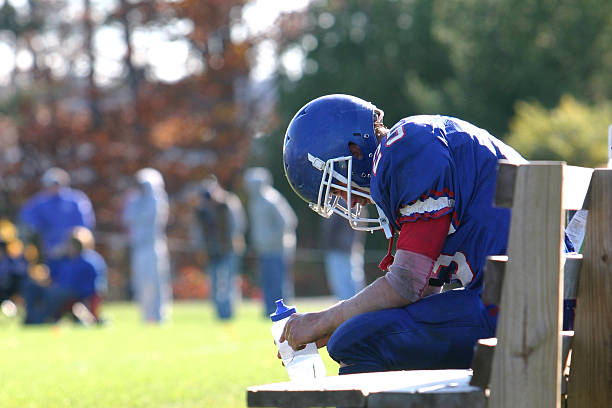The mercy rule, in sports, is when a team wins so much that the pace of the game is changed. This can be a variety of things, including having the game called, a running clock or many more different variations that different states and leagues incorporate, to not demoralize a losing team when down by an insurmountable amount. I will be trying to determine whether or not high school sports should have a mercy rule and what they should be set at in the scenario that they implement them.
Because I haven’t played any sports since middle school, I felt that it would be good to get an outside opinion from some football and volleyball players on a survey. I asked whether or not there should be a mercy rule in football, basketball, baseball, and softball, and gave them the options of yes, no, or maybe. In football and baseball, roughly half said yes with barely anyone saying no, but softball had only 37 percent say yes, which I believe is odd as softball and baseball are very similar sports, and having a different scoring system seems somewhat illogical. Basketball came in last at 18 percent yes and the rest being no. This isn’t surprising, as basketball, in nature, is a game that is heavily reliant on hot streaks by one team, making a comeback possible in almost any situation. In contrast, football, baseball, and softball tend to be tougher to make large comebacks in, as it is very difficult to shift momentum once down by a large margin.
In football, the mercy rule that’s in place is named the “35-Point Rule.” According to the NSAA, the running clock starts after a team has a 35-point lead in the first half, and is stopped if the lead becomes fewer than that. This has worked pretty well for a while, but in lieu of the recent halftime forfeit by Lincoln High against the Millard South Patriots on Oct. 10, where the score was 63-0 at the time of the forfeit, I believe it’s time to revisit what the number and actions that come into effect should look like.
Now there is very little information on the web of comebacks of a large deficit in high school football, so I turned to NCAA Division I College Football to get a gauge of where the reasonable limit is. According to ncaa.com, there have been nine comebacks of 30+ points since 1984. With this in mind, the 35-Point Rule doesn’t seem to be a very good guideline, as it would take a comeback that is larger than the largest in NCAA Division I history for a team to win a game. This along with the fact that high school sports tend to have less explosive offenses than what you’ll find in these college football games lead me to what I believe is a fair and reasonable number of points to implement a mercy rule. I would propose that if a team takes a 25-point lead, the clock will start running, and in the situation that the lead becomes fewer than 25, the clock will go back to normal time rules. If at any time from the end of the first half to the end of a game, a team takes a lead of 35 points or more, the game is called. These numbers are pretty fair in my opinion, as a 25-point differential is a 4-possession game, which would be highly unlikely for a team to make a comeback, and after 35 I don’t believe that it is feasibly possible for a high school team to make that comeback in 1 half, which is why I would have the game called at any time that this occurs past half time.
For softball and baseball, I will be bunching them together as they are very similar. However, the final decision for a mercy rule will be different as they have different inning totals. In high school baseball the “10-Run Rule” is where the game is called when a team is leading by 10 runs after 5 or 4 ½ innings. There is little to no information about comebacks in high school and college baseball, and I don’t believe that professional baseball is even remotely comparable to high school, so to establish what a fair number is based on historical info will be quite challenging, I look over to the rules in softball. The “8-10-12 Run Rule” makes it so that after 3 or 2 ½ innings if a team is up by 12 the game is called, after 4 or 3 ½ innings if a team is up by 10 the game is called, and after 5 or 4 ½ innings if a team is up by 8, the game is called. This seems like a very good baseline for the sport as it gives teams time to make a comeback, and as it becomes more and more far-fetched that a comeback is possible the points needed to call the game are lowered. I believe they should keep this rule in softball, raise the inning totals by 2 for each, and implement this into baseball. The only reason there is a change in the number of innings required to enact this is because the games go to 9 innings rather than 7.
The final sport I will be going over is basketball. Currently, the “40-Point Running Clock Rule” is in effect. This is when they put in a running clock after a 40-point lead after the first half. The running clock stops if the lead gets lower than the 40-point threshold. Now in the survey I conducted, over 80% of respondents said that they’d be against a mercy rule in basketball, which I somewhat agree with. I think it’s fair to let them play, but it’s also tough as there can be massive differences in talent in high school basketball from team to team.
Since there is no info on comebacks in high school basketball, I once again resort to college sports. According to CBS Sports, the largest comeback in college basketball history is 34 points. This leads me to a somewhat odd conclusion. I don’t think that basketball games should ever be called due to a large margin, as it’s almost always possible to make games close down the stretch, and I don’t like the running clock as it takes away time for the losing team to potentially make the margin somewhat respectable for themselves. I think that after a team goes up by 30, one way to keep the score from getting completely out of hand is to make 3-point shots worth 2 for the winning team. This would prevent a team from being able to easily run up the score, and would at the very least give the losing team the chance to outscore the winning team for a few possessions. I would also want to add that this change in scoring doesn’t go away until the winning team is up by 25 or fewer points. This addition simply allows the team who is down by a large margin to make that number a little less embarrassing.
Overall, there is no one solution to a standard mercy rule in each sport, as every class of every sport in every state has different problems that need to be addressed, but the proposals I came up with could be a solid guideline on how to adjust the rules for the future in high school sports. At the end of the day, these rules are only applicable to high school sports, as at this level teams aren’t meant to completely decimate competition, but rather to teach student-athletes how to work with a team doing an activity that they can enjoy, as the end goal of all high school athletics is for student-athletes to have fun doing the sport they love with their friends.








